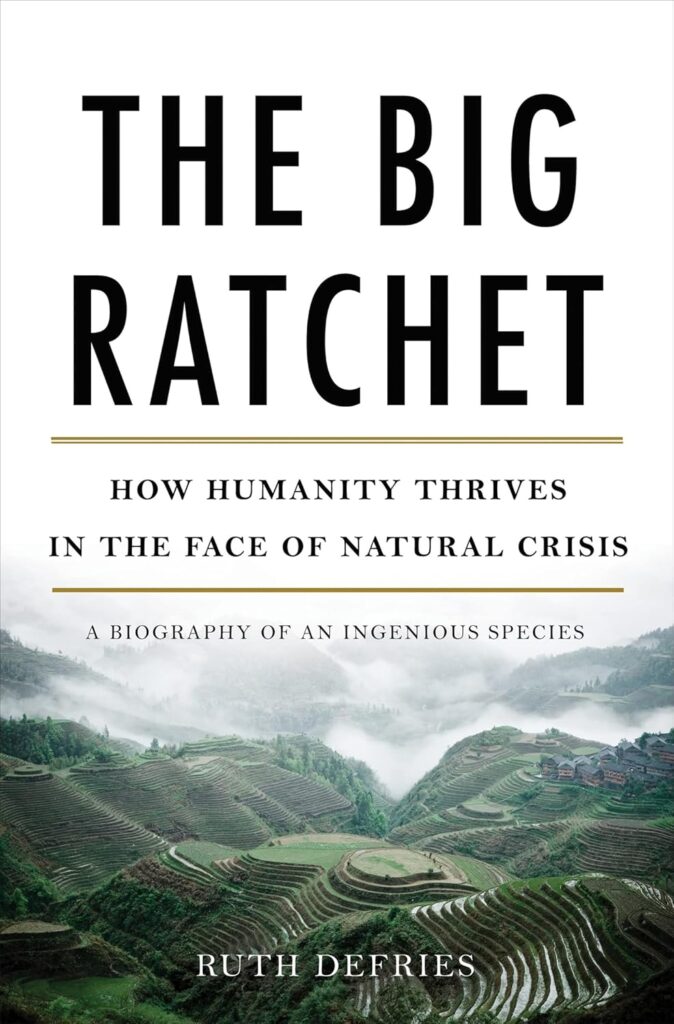Featured Book
The Big Ratchet
How Humanity Thrives in the Face of Natural Crisis
All of human history can been seen as a struggle to exploit nature to better feed ourselves in an endless three-step cycle of crisis and growth — of “ratchet,” (big breakthrough), “hatchet” (a crisis of unforeseen consequences) and “pivot” (some ingenious new solution). The last “Big Ratchet” was the shift from foraging to farming some 12,000 years ago. The current one is our transformation to an urban species, dependent on the manipulated nature of modern agriculture, the consequences of which we still don’t fully understand.
The Big Ratchet views human history, as species struggling to exploit nature to better feed and expand themselves. Humans have been spectacularly successful at this because of our relentless ingenuity. Each success ratchets up our numbers—and our needs. Eventually, nature’s limitations restrict our advances, create a crisis and “drop a hatchet” on our ambitions. So our ingenuity pivots to find a new twist of nature, creating a new ratchet, followed by a new hatchet, then a new pivot, and so on: an endless cycle of ratchet, hatchet, pivot. Each time, as our population and society grow, the stakes increase, making each hatchet potentially more catastrophic than the last. This book tells the story of the major ratchets, hatchets and pivots that have propelled us to this unprecedented, revolutionary juncture and transformed our species from agricultural to urban, a transformation we don’t yet understand but which may be the most significant yet.
Until recently, the biggest human ratchet was the shift from foraging to agriculture, about 12,000 years ago. Agriculture emerged on almost every continent within 7,500 years, transforming human society from nomadic groups to settlements with hierarchies of governance and non-food-related occupations. Agriculture fed more people more reliably, producing higher birth rates, earlier weaning of infants, and many centuries of population growth; but crowded living increased the spread of disease, and nutrition suffered from a more limited diet.
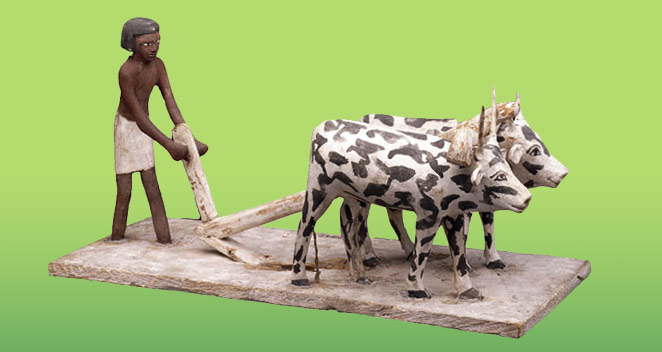
In 14th century Europe population outpaced food supply, unleashing a cycle of misery. Harsh weather, heavy taxes and military conflicts added to the suffering; bubonic plague and famines killed millions. The next few hundred years saw incremental improvements including the increased use of animal labor and early crop rotation schemes. By the mid-18th century the Agricultural Revolution drove swift production upsurges, furthered in part by more efficient crop selection, more animal labor, better plows and improved seeds. These gains coincided with the start of the Industrial Revolution and provided the surplus food it required.
By the mid-19th century, most Englishmen lived in cities, overwhelming waste recycling capabilities; flush toilets took over waste removal, and forced farmers to seek fertilizer elsewhere. In the new world, Incans had long fertilized with guano, nitrogen- and phosphorus-rich bird droppings accumulated over millennia on Peruvian islands. The end of the 18th century through the middle of the 19th saw a growing market for mining that guano and shipping it to Europe and the US. Over 50 years, excess usage depleted the supply and drove the European fertilizer market to South America’s inland saltpeter deposits, which were also useful for manufacturing gun powder. It also spurred the search for other means to renew soil nutrients.

By the 20th century scientific breakthroughs in manufacturing fertilizer had revolutionized agriculture, transforming diets and increasing the number of people the food supply could support—but these also introduced new hatchets. Excessive phosphorus causes algae to bloom in fresh water, killing fish and plants. Sewage treatment and phosphate-free detergents help, but runoff still creates problems today. Excess nitrates, beyond what bacteria can convert to nitrogen gas, move through streams to create enormous dead zones in coastal areas like the Gulf of Mexico and the Black Sea. And some nitrates end up as nitrous oxide, a greenhouse gas 300 times more warming than carbon dioxide.
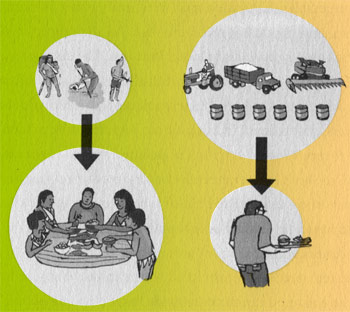
In the late 1800s, internal combustion engines introduced fossil-fuel-powered farming and enabled the construction of huge dams to control water on a scale previously unimaginable. The traditional energy equation—requiring food to supply more energy than expended to hunt, gather, or grow it—no longer applied. Today, fossil fuels replace most animal and human labor, although they expend 7 to 15 calories of energy for every one our food provides.
As the fertility and perceived energy obstacles fell, others appeared, including limited crop yields. Traditionally, plant breeders sold seeds from desirable specimens to farmers, generating constant yields. But early 20th century corn breeders dramatically improved yields; hybrid seed produced desired traits without inbred weakness and, by the mid-1950s, they accounted for 90% of US corn acreage. By 1960 yields had nearly doubled from the start of the century, with hybrid seeds accounting for half that increase, the remainder due to pesticides, chemical fertilizers, and new machinery.

Hybrid strains of wheat, soybeans, and rice followed corn, including semi-dwarf strains with shorter, stiffer stalks that don’t fall over in wet, irrigated soil. Big Ratchet was underway, transforming Midwest farming into large operations focused on a few crops and requiring less labor than ever before.
But monocultures—large fields of uniform crops—are particularly vulnerable to pests like birds, rodents, insects, bacteria and fungi, which exploit crops’ proximity and genetic similarity, consuming almost 30% of crops worldwide. And pests spread through shipping and human travel, become invasive in environments with few or no predators. Farmers have always battled pests with varied strategies, including chemicals (the Chinese employed arsenic as pesticide over a thousand years ago), but chemical pesticide use proliferated from the mid-19th century through the advent of DDT in the mid-20th.
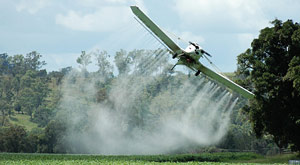
In the 1940s, DDT appeared. It destroyed lice and mosquitos and controlled typhus and malaria outbreaks, eliminating malaria entirely from temperate climates. But by the early 1960s, natural selection had enabled pests to develop resistance, and properties making DDT effective also made its side effects devastating: not being water soluble, it passes through streams, lakes, and oceans into fish and amphibians and the animals which eat them. DDT is fat soluble, so it accumulates in animal tissue, magnifying its consequences as it moves up the food chain.
The US banned DDT in 1972, and other countries soon followed. Pesticides appear to cause a wide range of maladies, including cancer, diabetes, and birth defects; over 90 countries adopted the Stockholm Convention, limiting production and use of a dozen persistent organic pollutants (POPs), including DDT, as of 2004. Apparently, pests cannot be eliminated, only controlled. Agriculture is now pivoting toward “integrated pest management,” a strategy which includes mixed crops, natural predators, and less-harmful, targeted, biodegradable pesticides.
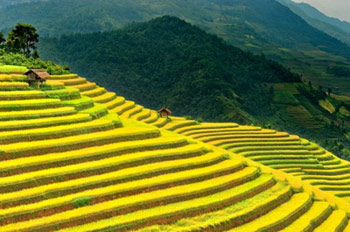
Decades before DDT, Japanese scientists discovered that a bacterium in the soil, Bacillus thuringiensis (Bt), kills insects, leaving plants and other animals unharmed, so they cultivated its spores to produce a spray insecticide. In the 1990s, scientists began splicing Bt-enabling genes into potatoes, corn and cotton, genetically arming the plants against insects. We now grow millions of acres of genetically engineered crops, bypassing natural selection to directly introduce desired traits into crops like Roundup Ready soybeans, which resist the effects of herbicides, and Golden Rice, which is enriched with vitamin A and iron.
But western agricultural success did not keep pace with 20th century population growth elsewhere. In India, for example, a 1940s famine claimed 3 million lives, and poor harvests in the 1960s again created a dire situation. But during the 1940s, ‘50s and ‘60s, plant breeder Norman Borlaug collaborated with others in Mexico, India, and the Philippines to spread dwarf genes, sterile pollen and other advances, creating “the Green Revolution” to boost food production in the developing world and move our agricultural achievements toward global reach.
In the 20th century, humanity grew from fewer than 2 billion, with less than 15% city-dwellers, to over 6 billion; as of May, 2007, the majority live in cities, supported by agriculture covering nearly 35% of the world’s land surface. The challenges created by this Big Ratchet are unprecedented: the rich and poor are farther apart than ever, our diets have become unhealthy, and our progress is changing the planet in threatening ways.
Green Revolution techniques require bigger farms, more machinery, chemical fertilizers and pesticides—and they are not available to typical farmers in the poorest countries. So even though we produce enough food for everyone, it is not distributed widely enough: hunger persists where poverty prevails.
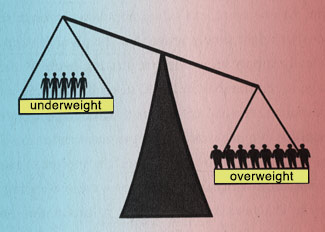
As hunger declines, obesity climbs because we eat less nutritious, processed, refined foods. Fewer than a billion people are hungry, but more than a billion are overweight. By 2030 the US is projected to become majority obese and 86% overweight.
Traditionally, the wealthier people become, the more animal products they eat. This trend adds to the impact of the Big Ratchet on three sustaining features of our environment: a stable climate, a planetary recycling mechanism, and an extensive variety of plant and animal life.
Greenhouse gasses have already created climate volatility, and we can no longer expect continuation of the Holocene climate stability we have known since becoming farmers. More than 25% of human-generated greenhouse gasses come from agriculture: nitrous oxide from fertilizers, methane from livestock, and carbon dioxide from fires to clear forests for planting. Fossil fuel emissions, of course, make matters worse.
Nitrogen from fertilizer causes destruction in lakes and coastal waters, while mining of phosphates and diversion of water above and below ground threaten earth’s machinery for recycling water, nitrogen and phosphorus. Perhaps most critically, deforestation and cultivation of a selected few species is reducing the variety of plants and animals that enabled our species to emerge in the first place.
The quest to produce sufficient food for all humanity succeeded in the second half of the 20th century – and is our biggest ratchet yet. Food production today yields more nutrition and requires less time, per capita, than ever before. This achievement, plus increased sanitation and public health practices, have extended average life expectancy by two decades.
We don’t yet know whether the achievements of this Big Ratchet are real, or temporary and high cost. But the transformation is as great as any our species has ever seen: we are now an urban species, dependent on a manipulated nature. Whether we can devise successful new pivots is not yet clear, but developments seem promising, focusing on what we eat and how we manipulate nature. Reducing waste and improving storage will reduce water, energy, and fertilizer requirements. More plant-based diets will reduce greenhouse gasses and land and fertilizer requirements. Current trends are small steps, but they suggest opportunities to overcome the problems created by this ratchet. Our population will plateau at about 9 billion in the middle of the current century, when nearly 70% will live in cities (vs. 30% in the mid-20th Century). Our ingenuity will be challenged to continue twisting nature to ratchet up our success as a species in transformation from farmers to urbanites.
In the series: A Sustainable Planet
- Our Finite Planet
- Our Climate Crisis—and What We Can Do About It
- Our Looming Global Water Crisis
- Our Plastic Earth
- Rescuing the Planet by Tony Hiss
- The Future: Six Drivers of Global Change
- Our Choice: A Plan to Solve the Climate Crisis
- The Sixth Extinction
- Natural Capitalism
- Foragers, Farmers, and Fossil Fuels
Related articles:
Further Reading
External Stories and Videos
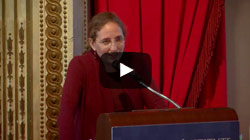
Watch: Book Launch: The Big Ratchet by Ruth DeFries
Professor Ruth DeFries asks “How did we get to be the species that dominates the planet? Can we see any pattern? Can we see any guidance for the future by taking this long lens back on our domination?”


